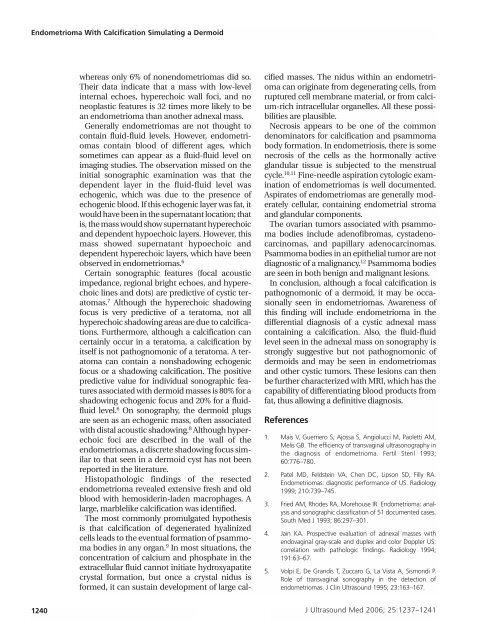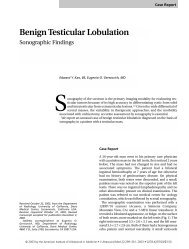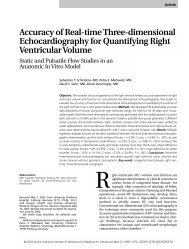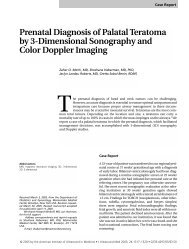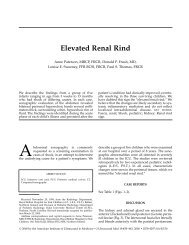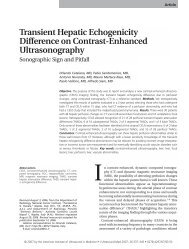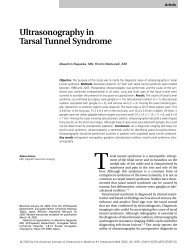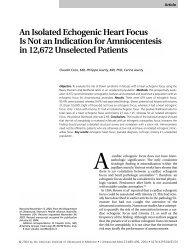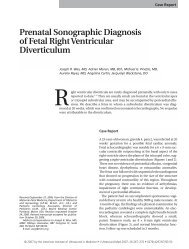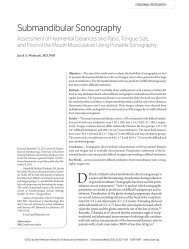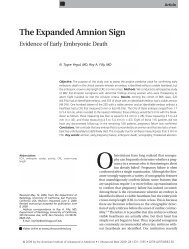Endometrioma With Calcification Simulating a Dermoid - Journal of ...
Endometrioma With Calcification Simulating a Dermoid - Journal of ...
Endometrioma With Calcification Simulating a Dermoid - Journal of ...
Create successful ePaper yourself
Turn your PDF publications into a flip-book with our unique Google optimized e-Paper software.
<strong>Endometrioma</strong> <strong>With</strong> <strong>Calcification</strong> <strong>Simulating</strong> a <strong>Dermoid</strong><br />
whereas only 6% <strong>of</strong> nonendometriomas did so.<br />
Their data indicate that a mass with low-level<br />
internal echoes, hyperechoic wall foci, and no<br />
neoplastic features is 32 times more likely to be<br />
an endometrioma than another adnexal mass.<br />
Generally endometriomas are not thought to<br />
contain fluid-fluid levels. However, endometriomas<br />
contain blood <strong>of</strong> different ages, which<br />
sometimes can appear as a fluid-fluid level on<br />
imaging studies. The observation missed on the<br />
initial sonographic examination was that the<br />
dependent layer in the fluid-fluid level was<br />
echogenic, which was due to the presence <strong>of</strong><br />
echogenic blood. If this echogenic layer was fat, it<br />
would have been in the supernatant location; that<br />
is, the mass would show supernatant hyperechoic<br />
and dependent hypoechoic layers. However, this<br />
mass showed supernatant hypoechoic and<br />
dependent hyperechoic layers, which have been<br />
observed in endometriomas. 6<br />
Certain sonographic features (focal acoustic<br />
impedance, regional bright echoes, and hyperechoic<br />
lines and dots) are predictive <strong>of</strong> cystic teratomas.<br />
7 Although the hyperechoic shadowing<br />
focus is very predictive <strong>of</strong> a teratoma, not all<br />
hyperechoic shadowing areas are due to calcifications.<br />
Furthermore, although a calcification can<br />
certainly occur in a teratoma, a calcification by<br />
itself is not pathognomonic <strong>of</strong> a teratoma. A teratoma<br />
can contain a nonshadowing echogenic<br />
focus or a shadowing calcification. The positive<br />
predictive value for individual sonographic features<br />
associated with dermoid masses is 80% for a<br />
shadowing echogenic focus and 20% for a fluidfluid<br />
level. 6 On sonography, the dermoid plugs<br />
are seen as an echogenic mass, <strong>of</strong>ten associated<br />
with distal acoustic shadowing. 8 Although hyperechoic<br />
foci are described in the wall <strong>of</strong> the<br />
endometriomas, a discrete shadowing focus similar<br />
to that seen in a dermoid cyst has not been<br />
reported in the literature.<br />
Histopathologic findings <strong>of</strong> the resected<br />
endometrioma revealed extensive fresh and old<br />
blood with hemosiderin-laden macrophages. A<br />
large, marblelike calcification was identified.<br />
The most commonly promulgated hypothesis<br />
is that calcification <strong>of</strong> degenerated hyalinized<br />
cells leads to the eventual formation <strong>of</strong> psammoma<br />
bodies in any organ. 9 In most situations, the<br />
concentration <strong>of</strong> calcium and phosphate in the<br />
extracellular fluid cannot initiate hydroxyapatite<br />
crystal formation, but once a crystal nidus is<br />
formed, it can sustain development <strong>of</strong> large calcified<br />
masses. The nidus within an endometrioma<br />
can originate from degenerating cells, from<br />
ruptured cell membrane material, or from calcium-rich<br />
intracellular organelles. All these possibilities<br />
are plausible.<br />
Necrosis appears to be one <strong>of</strong> the common<br />
denominators for calcification and psammoma<br />
body formation. In endometriosis, there is some<br />
necrosis <strong>of</strong> the cells as the hormonally active<br />
glandular tissue is subjected to the menstrual<br />
cycle. 10,11 Fine-needle aspiration cytologic examination<br />
<strong>of</strong> endometriomas is well documented.<br />
Aspirates <strong>of</strong> endometriomas are generally moderately<br />
cellular, containing endometrial stroma<br />
and glandular components.<br />
The ovarian tumors associated with psammoma<br />
bodies include aden<strong>of</strong>ibromas, cystadenocarcinomas,<br />
and papillary adenocarcinomas.<br />
Psammoma bodies in an epithelial tumor are not<br />
diagnostic <strong>of</strong> a malignancy. 12 Psammoma bodies<br />
are seen in both benign and malignant lesions.<br />
In conclusion, although a focal calcification is<br />
pathognomonic <strong>of</strong> a dermoid, it may be occasionally<br />
seen in endometriomas. Awareness <strong>of</strong><br />
this finding will include endometrioma in the<br />
differential diagnosis <strong>of</strong> a cystic adnexal mass<br />
containing a calcification. Also, the fluid-fluid<br />
level seen in the adnexal mass on sonography is<br />
strongly suggestive but not pathognomonic <strong>of</strong><br />
dermoids and may be seen in endometriomas<br />
and other cystic tumors. These lesions can then<br />
be further characterized with MRI, which has the<br />
capability <strong>of</strong> differentiating blood products from<br />
fat, thus allowing a definitive diagnosis.<br />
References<br />
1. Mais V, Guerriero S, Ajossa S, Angiolucci M, Paoletti AM,<br />
Melis GB. The efficiency <strong>of</strong> transvaginal ultrasonography in<br />
the diagnosis <strong>of</strong> endometrioma. Fertil Steril 1993;<br />
60:776–780.<br />
2. Patel MD, Feldstein VA, Chen DC, Lipson SD, Filly RA.<br />
<strong>Endometrioma</strong>s: diagnostic performance <strong>of</strong> US. Radiology<br />
1999; 210:739–745.<br />
3. Fried AM, Rhodes RA, Morehouse IR. <strong>Endometrioma</strong>: analysis<br />
and sonographic classification <strong>of</strong> 51 documented cases.<br />
South Med J 1993; 86:297–301.<br />
4. Jain KA. Prospective evaluation <strong>of</strong> adnexal masses with<br />
endovaginal gray-scale and duplex and color Doppler US:<br />
correlation with pathologic findings. Radiology 1994;<br />
191:63–67.<br />
5. Volpi E, De Grandis T, Zuccaro G, La Vista A, Sismondi P.<br />
Role <strong>of</strong> transvaginal sonography in the detection <strong>of</strong><br />
endometriomas. J Clin Ultrasound 1995; 23:163–167.<br />
1240 J Ultrasound Med 2006; 25:1237–1241


